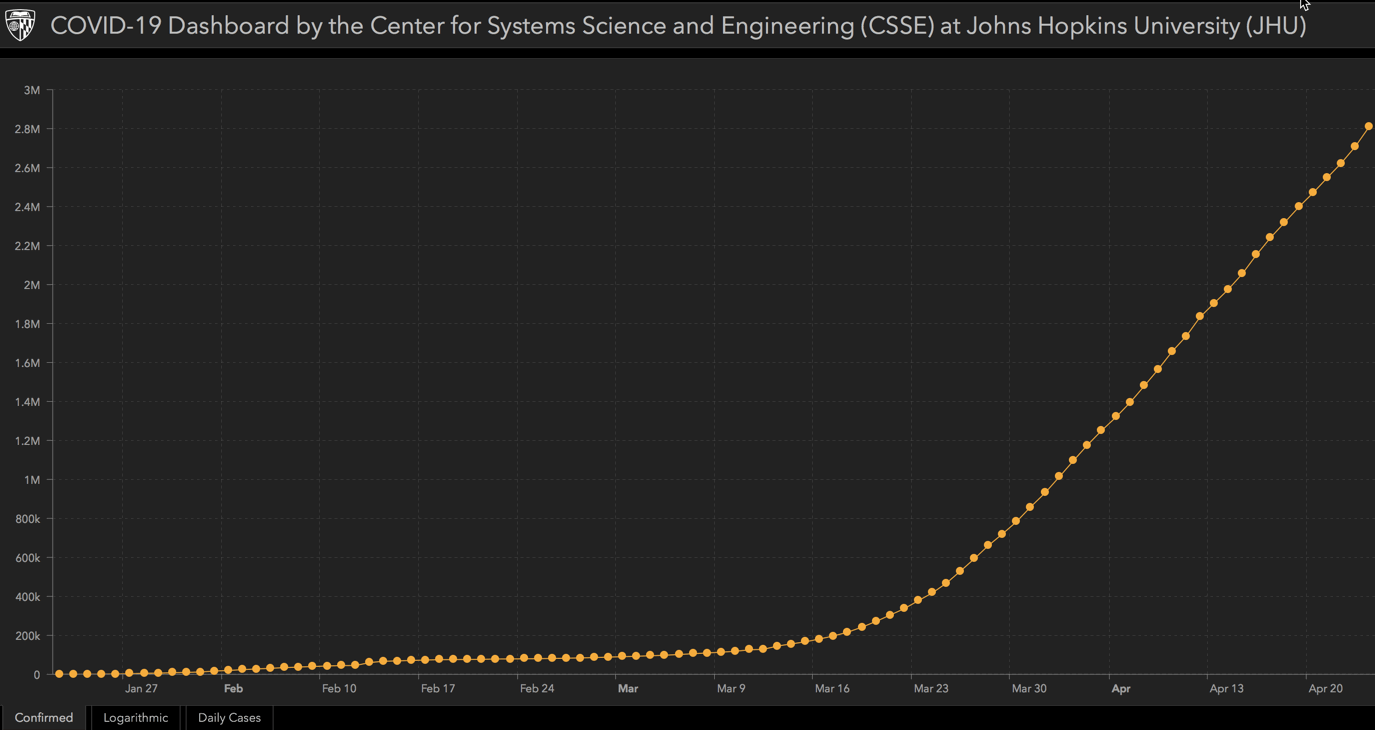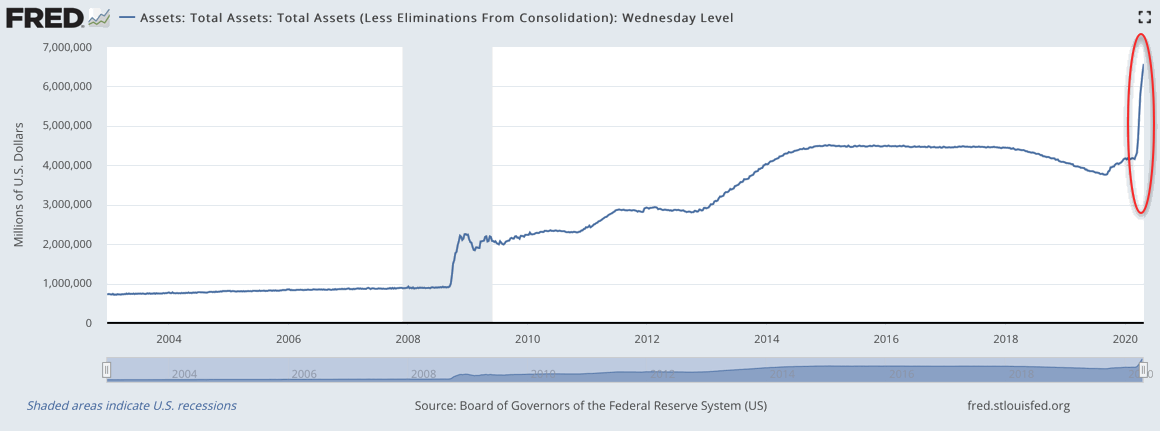As the coronavirus continues to spread, the combined health and economic impacts are likely to be truly massive.
Where did it all go wrong?
Since this is not a medical sciences blog, we will leave the health related issues to the relevant experts. However, that leaves plenty of topics to examine on the economic front.
Since the start of February this year, the Fed has expanded its balance sheet by more than $2.4 trillion. To put that in context, the Fed was created in 1913, and its total balance sheet assets only reached $2.4 trillion towards the end of 2010. That means it took 97 years to add the first $2.4 trillion in assets, but only 2 months to achieve the same amount of balance sheet expansion this year.
What does Fed balance sheet expansion mean for the US economy?
Well, the way the Fed expands its balance sheet is by buying financial assets: US government securities, agency securities, mortgage backed securities. The way the Fed can afford to buy so many financial assets is that it does so with newly printed (read: digitally created) money. As a result, Fed balance sheet expansion tells us that they are significantly increasing the money supply.
This will cause prices to rise, perhaps rapidly, as soon as some confidence and semblance of normalcy returns and people start spending again.
Recently, an economist by the name of Steve Keen was interviewed on Youtube. Keen is a world famous economists, and for the most part someone who I really respect and enjoy listening to. It was mildly concerning then to hear Keen say a number of things about money and the global monetary system which on their face would appear to be incorrect.
In particular, Keen made four claims:
- Gold is not money
- Individuals can save, but there can never be any saving in the economy, taken as a whole, because one person’s spending is another person’s income
- Increased saving reduces the rate of spending, and so will reduce demand and slow economic recovery
- Governments around the world should address rising debt levels by instituting a debt jubilee
The Youtube video below discusses the three stages of money and Keen’s first three claims (watch it at 2x speed). And for a discussion of each of Keen’s four claims, please keep reading below.
1. Gold is money
Keen argues that gold is not money and is only needed in certain circumstances for international settlement between nation states.
To understand whether this claim makes sense, let’s ask a few simple questions.
Firstly, what is money? The most basic definition of money is any asset that is generally accepted as a means of payment to settle debts. So, in essence, Keen is saying that gold is international money. It is used to settle debts between nation states.
Secondly, what is ‘good’ money? Good money is often said to possess six qualities; an asset that is durable, portable, divisible, uniform, generally acceptable and limited in supply. The first five qualities make good money useful as a means of payment, and the sixth quality makes good money useful as a store of value. Gold satisfies all of these criteria.
From 1944 to 1971, the global monetary system was backed by gold. Under the Bretton Woods System, gold could be purchased at a fixed price of around US$35 per ounce. American dollars were used willingly for global trade because they were a claim on gold. Gold was the good money, and US paper was a claim on gold.
In 1971, President Richard Nixon took America off the gold standard. This means that the price of gold is no longer fixed, and tends to fluctuate and rise over time as the US dollar loses its value.
If Keen is sincere in his belief that gold is not money, then he should find it truly baffling that the US holds more than 8,000 metric tons of gold in reserve.
2. Economies can and should save
Keen argues that one person’s spending is another person’s income. Hence, while individuals can save, there can’t be saving in the economy taken as a whole.
The flaw in this reasoning is that it conflates flow variables (income, consumption, investment, and government spending) with stock variables (savings).
If you think of the national economy as a business, then flow variables would appear on the national income statement, and stock variables would appear on the national balance sheet. In any given year, total spending can be higher than total income. This can happen if the economy draws down on its savings or increases its level of debt.
I’ve built a simple theoretical model, which shows that this common sense intuition actually makes sense. If you’re interested, you can download it here. Keen’s traditional view is based on the circular flow model. Given its name, ‘flow model’, it is no wonder that the traditional approach overlooks stock variables and the role of the balance sheet in the national economy.
Saving is used to carry purchasing power from one year to the next. An economy which saves more, will have more purchasing power in future periods, and hence more ability to consume, invest, or repay its debts.
3. Increasing our stock of productive capital requires a pool of savings
Keen argues that increased saving reduces the rate of spending. Since he thinks that total spending equals total income in the economy, he concludes that more savings (aka “austerity”) will reduce national income.
Even if Keen’s argument were true, individuals and businesses that consistently spend more than their income will either go bankrupt or lose their freedom and become wards of the state. Hence, spending less than you earn is crucial.
Free market capitalism is about increasing the stock of productive capital over time. Loosely speaking, there are two main ways for a business to do this: invest retained earnings (i.e. use business savings) or invest money received by selling financial assets to investors (i.e. use household savings).
Why should we want to increase the stock of productive capital over time? Adam Smith perhaps said it best:
“The riches, and so far as power depends upon riches, the power of every country must always be in proportion to the value of its annual produce, the fund from which all taxes must ultimately be paid.”
Hence, it might be argued that saving is more important than spending. It is only by sacrificing the present for the future, it is only by saving, that an economy accumulates a stock of money that can be used to invest in productive capital.
4. Debt jubilee sounds nice ‘in theory’
Keen argues that we should organise a debt jubilee, forgiving debts that households, businesses and governments have accrued by spending more than they earn for many years. Given the amount of debt washing around in the global economy, this does sound like a good idea, at least in theory. However, a mechanism for debt forgiveness already exists in the economy. It is called “bankruptcy”.
When borrowers get in over their heads, and become unable or unwilling to meet their obligations, they have an option available. By communicating with lenders, borrowers have the potential to renegotiate and restructure their debts. Restructuring could happen via writing down debts, reducing interest rates, or delaying payments.
Bankruptcy is an appropriate mechanism for debt forgiveness because it allows individual borrowers to negotiate with individual creditors, based on the specific circumstances of each individual case.
Keen’s proposed alternative to bankruptcy is partial debt forgiveness on an economy wide basis. The mechanism would work by injecting cash into peoples’ bank accounts, and requiring anyone with debt to use the extra cash to pay down their debts.
While a cash injection is bound to be popular, especially amongst advocates of Universal Basic Income, we should be mindful of the potential unintended consequences:
- If the cash injection is financed with newly printed money, then this will increase the money supply. This is likely to push up prices once confidence returns and the rate of spending increases. This could lead to higher consumer prices, speculative asset bubbles or both.
- If the cash injection is financed by raising taxes, then this would mean that private losses are being bailed out by tax payers. This is hardly fair, and will likely lead to social unrest and more movements like ‘Occupy Wall Street‘.
- A broad based economy wide debt jubilee would most likely create extreme moral hazard, encouraging excessive risk takers to continue their behaviour unchecked and unchastened. By rewarding the reckless, government would in effect be punishing the prudent.
Conclusion
As Warren Buffett is famous for saying, “Only when the tide goes out do you discover who’s been swimming naked.”
COVID-19 is an unexpected low tide for the global economy, and over the coming year we will no doubt discover that there were many more people skinny-dipping than anyone thought possible.
Only by thinking clearly can we help individuals, businesses, and governments make sensible decisions during this difficult period of time.
What do you think about Steve Keen’s views on the economy?
What do you think about my responses?
I’m open to your views and opinions. Please comment below. I value your insights!
🔴 Like this article?
Sharpen your edge in consulting


2 replies on “Rising COVID cases, falling economy”
Such an interesting piece Tom.
Indeed a debt jubilee is painful in reality because the debts that are wiped out or reduced in value leads to the creditor losing their wealth. And might I add that the debt problem didn’t necessarily arise in isolation but through a series of less prudent spending patterns. To write off debts without correcting the behavior is futile.
Gold is money as you state. I believe the prime reason why President Nixon moved away from the Gold standard was because claims on gold were being turned in for actual gold and the claims were greater than the amount of gold that was available to redeem the claims.
I believe that further cash injections by increasing money can’t be made without the inevitable devaluation of the respective currency. This is why countries need to save for such a “Rainy day” or “Dooms Day” scenario
Thank you for your comment, Oduor!